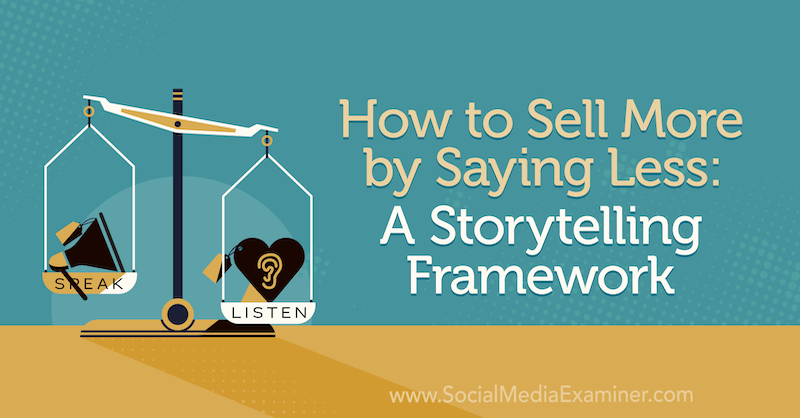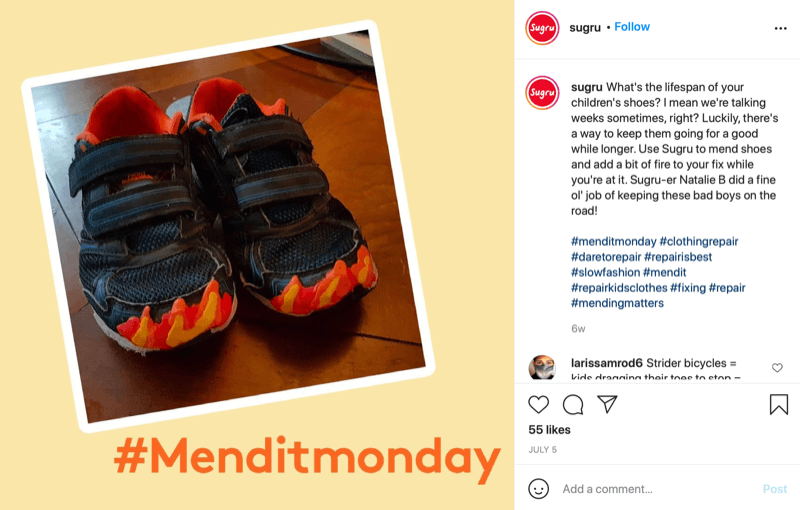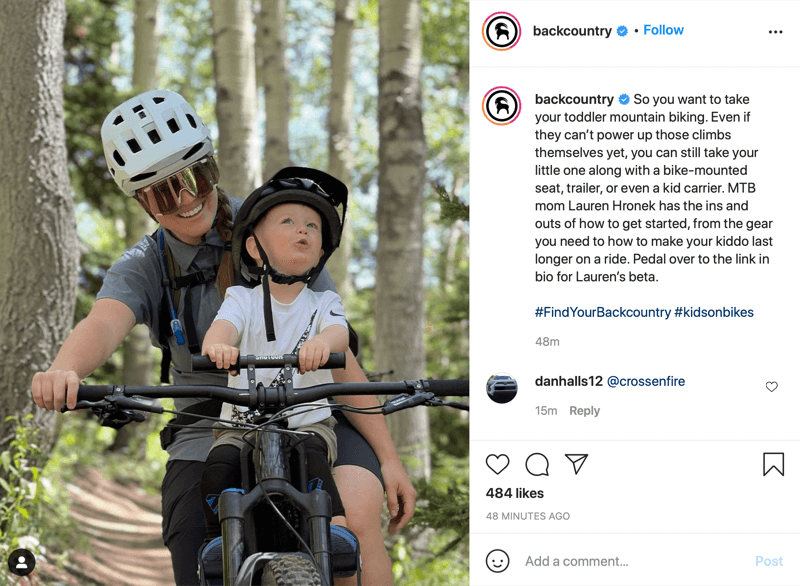Are you looking for an easier way to persuade people? Do you want more leads and sales?
In this article, you'll discover a unique storytelling framework that will help you leverage the power of stories.

Why Marketers Should Focus on Storytelling
Years ago, customers focused on the features and benefits of a product they were interested in. If they needed a new computer, they went into the stores asking about the features that were important to them: how fast was the processor, how much memory did it have, how big was the hard drive?
Today, there are far too many variables for customers to focus on individual features and benefits. Additionally, as consumers have grown more sophisticated, the need for a real connection has also grown.
Now when marketers lead with features or functions of a product with a little bit of those benefits thrown in, it sounds more like chest-pounding around the brand: talking about how wonderful the product or service is and how customers should just trust you and buy it. Messages like that don't resonate; they don't work because consumers aren't as focused on features as they used to be.
However, when you tell a story and put your audience at the center of that story, your customer becomes the hero of your story. That's becoming a very popular rule of thumb now for the brand's story to be more about the customers than about the brand.

And as brands and marketers do this, they develop a deeper engagement with their customers because it helps them understand and empathize with everything their audience actually wants, as well as why it's important to them.
Where You Can Use Storytelling in Your Marketing
Any brand selling any service or product can use storytelling. It can be used in every aspect of messaging and communication including social media posts, short tweets, long-form posts, emails, and leading into demonstrations. And as you adopt the ABT storytelling method (which we'll cover in detail in a minute) into your messaging, you'll find you need fewer words to get your point across. Your emails and your content will be shorter and more to the point.
And not only that, but this storytelling method leads to a natural call to action (CTA) that's built right into it, so you can add a CTA without jarring your audience or having to pivot into an awkward turn. This means your story will work on your landing pages, your opt-ins, and your sales pages. And your audience will love you for it.
This method isn't just for online use. You can also use it for your sales presentations, either virtual or in person. If you start with the singular narrative it provides, it'll help you stay focused through your presentation and make it easier for your audience to digest everything. And because everything is easier to digest, your audience becomes more interactive, they lean in more, and they'll ask you to take them further.
Now let's look at this storytelling framework and how you can use it to tell stories in your own marketing.
#1: The ABT Method: A 3-Part Storytelling Framework
The ABT method of storytelling helps you boil down the problem and the solution into one concise statement while connecting with your audience and inviting further engagement.
ABT stands for: And, But, and Therefore. This is the story template you'll use to bring focus to your audience.
Get World-Class Marketing Training — All Year Long!
Are you facing doubt, uncertainty, or overwhelm? The Social Media Marketing Society can help.
Each month, you’ll receive training from trusted marketing experts, covering everything from AI to organic social marketing. When you join, you’ll also get immediate access to:
- A library of 100+ marketing trainings
- A community of like-minded marketers
- Monthly online community meetups
- Relevant news and trends updates
And this is exactly what this storytelling framework helps you do. It makes you focus by making you research, understand, and empathize with your audience. By putting together your story this way, you can identify what your audience wants, learn how to articulate it to your audience clearly and concisely, and establish a deep connection that helps your audience trust you.

This narrative tool helps ensure that you understand what your audience is after, as well as what's standing in your audience's way. But it's also a powerful listening tool.
As your customers approach you listing their many problems, you can restructure their problems into a story, reframing their list into a concise narrative. And as you do that, your customers will be amazed at how well you understand and make sense of the jumble of problems they spit out at you.
The Statement of Agreement: And
The first part of ABT is the And. The And is your statement of agreement with the audience. This is the piece of your story that helps establish a connection and proves that you understand what your audience is after. If you're used to listing features—Feature A and Feature B and Feature C and Feature D—you're going to come down to one And: what your audience wants And why it's important to them.
This first statement helps you validate your audience by letting them know you understand what's important to them and what's at stake in their life or business.
Traditionally, marketers and sellers are trained to lead with a problem statement. However, the issue with this approach is that if your audience doesn't see it as a problem the same way you do, you're already creating an adversarial relationship. They're going to tell you no before they even have a chance to get to know you. Once this happens, you have to prove yourself to your audience.
It's far more powerful to lead the conversation with what your audience wants. If you can get them to imagine what a better tomorrow can look like after they've achieved what they want, you'll be demonstrating to your audience that you actually understand, empathize, and care about what they want. You'll see them start nodding along with you and agreeing with your statements.
They're already telling you yes.
The Problem Statement: But
Now that you have your audience nodding along in agreement with your And statement, it's time to pull the rug out from under their feet and remind them that they don't have it yet. This is where you state the problem: You don't have these things yet because of this problem you're facing.
You want to make sure that your But statement is succinct and specific and creates a contradiction. The greater the contrast you can create between the And statement and the But statement, the more your audience will lean in to listen to your solution.
The But is critical. In fact, But is probably the single most powerful word in the English language because it signifies change. The second you use it in a sentence, the ears perk up and your audience braces for that change.
In certain contexts, you do want to avoid “but” so you don't accidentally negate everything you've said. However, when you're talking to your audience specifically about sales, the word “but” can be one of your most powerful tools. Especially when it comes to your storytelling.

Discover Proven Marketing Strategies and Tips
Want to go even deeper with your marketing? Check out the Social Media Marketing Podcast! Publishing weekly since 2012, the Social Media Marketing Podcast helps you navigate the constantly changing marketing jungle, with expert interviews from marketing pros.
But don’t let the name fool you. This show is about a lot more than just social media marketing. With over 600 episodes and millions of downloads each year, this show has been a trusted source for marketers for well over a decade.
The Solution: Therefore
Once you've established your connection with your audience with the And statement of agreement, and pulled the world out from beneath them with the But for the problem statement, then it's time to come in with the Therefore. The Therefore is your story. This is your solution statement, how you're there to help your audience get what they want by helping them overcome whatever is standing in their way.
Because this is the part of your story that's about you, it's also the most natural part of your story and flows smoothest.
There are technically two parts to the Therefore: the What and the How. This is where you explain what people need to get to overcome their obstacles and how they can go about getting it.
Putting It All Together
Once you join each of these pieces together, your completed story looks something like this:
You want [what] And [why it's important], But [problem]. Therefore, you have to get [what] by [how].
Here's an example using this framework:
You want to make more money in affiliate marketing and finally get out of the 9-to-5 rut, but no one is coming to your website. Therefore, you need to learn how to use social media to promote your website by attending this talk at our social media marketing conference.
The ABT method of storytelling helps you boil down the problem and the solution into one concise statement while connecting with your audience and inviting further engagement.
#2: Why This Storytelling Method Works
There's a lot of evolution and science that goes into just why this storytelling method works so well. The subconscious limbic system is made up of the amygdala and the hippocampus, and together they carry out more primal, emotional responses and functions in the brain that operate automatically.
This area of the brain operates purely out of instinct. And that instinct is what has guaranteed our survival since we developed into Homo sapiens.
But it gets better. One of the most interesting things about the human brain is that while it makes up 2% of our body mass, it consumes 20% of our calories (the energy we consume), and it does this for one function: our survival.
So the brain is constantly working in the background consuming energy. If we confuse it or bore it with our messaging, it shuts down because it needs to. Our brain wants to be lazy and conserve energy for a fight-or-flight situation, which comes down to survival.
When you write and deliver an ABT story, you're tapping into the limbic system of the brain, that part of the brain that works and drives on instinct. You want to be able to use the same patterns that the limbic system loves—cause and effect, problem and solution—in your messaging.
That's what makes your story so powerful. Because you're not appealing to the customer's logical side of the brain that rationalizes and justifies purchases; rather, you're appealing to the emotional subconscious mind where all of people's real buying decisions are made.

Once you start writing and using your own story using this framework, you'll realize just how easy and powerful this method of storytelling can be. You'll increase your sales while actually saying less because you'll have made your audience the hero of your story, established a strong connection with them, and led to a natural CTA toward your solution.
#3: Outline Your Own Story Using This Framework
The best way to write out your ABT story is to start with your But statement: the problem. Get a piece of paper, put a big But there, and write down “but the problem is [this].”
Chances are, you already know some of the significant pain points and problem statements your customers or clients deal with on a daily basis. So this is your chance to really zoom in on each of these struggles and write them out in a separate statement.
For each But, you'll then add the appropriate Therefore statement. You might even use the same Therefore statement for multiple Buts. Or if you solve multiple problems, then each one will have its own Therefore statement.
Finally, you work in the And statement before the But. Remember, you want to build as much contrast between the And statement and the But statement. The more people nod with you during your statement of agreement, the more powerful your But statement will be when it pulls the rug out from under them and the more they'll lean in for the solution when you present it with your Therefore statement.
Park Howell is a storytelling strategist who helps marketers and content specialists grow their businesses using story. His podcast is The Business of Story. He's author of Brand Bewitchery: How to Wield the Story Cycle System to Craft Spellbinding Stories for Your Brand and his latest book co-authored with Randy Olson is The Narrative Gym for Business. His course is called the ABT's of Selling. You can connect with Park on LinkedIn.
Other Notes From This Episode
- Episode sponsored by Sked Social. For an extended 2-week trial and 50% off your first month, visit skedsocial.com/sme.
- Check out the Social Strategy Club at socialmediaexaminer.com/club.
- Connect with Michael Stelzner at @Stelzner on Instagram.
- Watch exclusive content and original videos from Social Media Examiner on YouTube.
- Tune into our weekly Social Media Marketing Talk Show. Watch live on Fridays at 12 PM Pacific on YouTube. Listen to the replay on Apple Podcasts or Google Podcasts.
Listen to the Podcast Now
This article is sourced from the Social Media Marketing Podcast, a top marketing podcast. Listen or subscribe below.
Where to subscribe: Apple Podcasts | Spotify | YouTube Music | YouTube | Amazon Music | RSS
❇️ Help Us Spread the Word! Please let your Twitter followers know about this podcast. Simply click here now to post a tweet.
✋🏽 If you enjoyed this episode of the Social Media Marketing podcast, please head over to Apple Podcasts, leave a rating, write a review, and subscribe.
Attention Agency Owners, Brand Marketers, and Consultants

Introducing the Marketing Agency Show–our newest podcast designed to explore the struggles of agency marketers.
Join show host and agency owner, Brooke Sellas, as she interviews agency marketers and digs deep into their biggest challenges. Explore topics like navigating rough economic times, leveraging AI, service diversification, client acquisition, and much more.
Just pull up your favorite podcast app, search for Marketing Agency Show and start listening. Or click the button below for more information.

